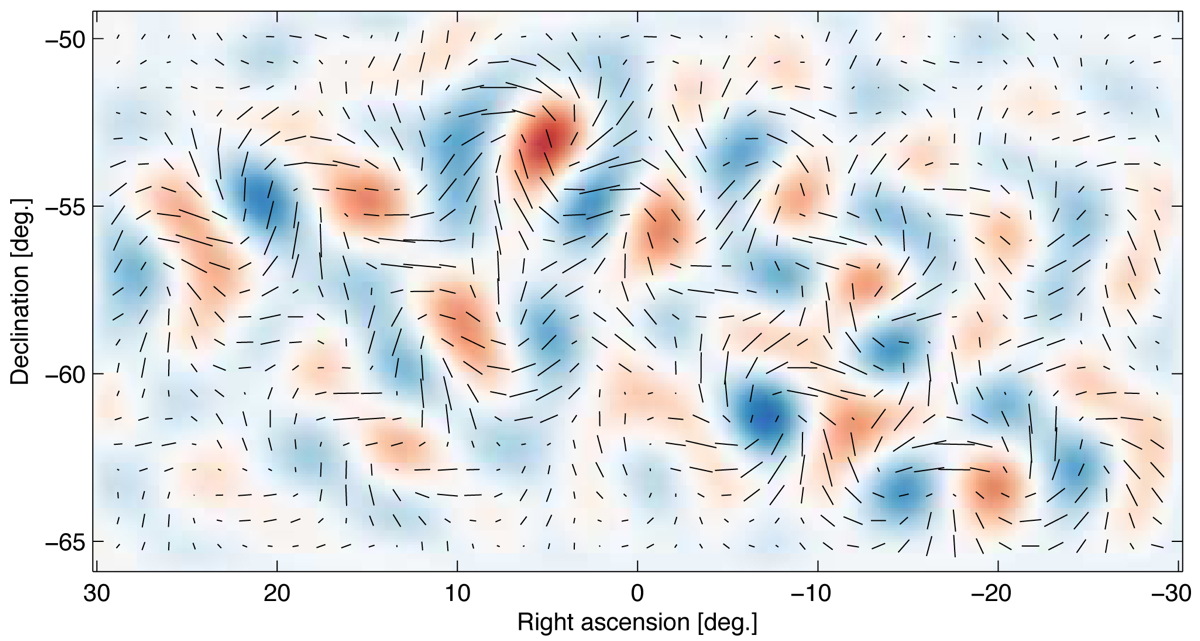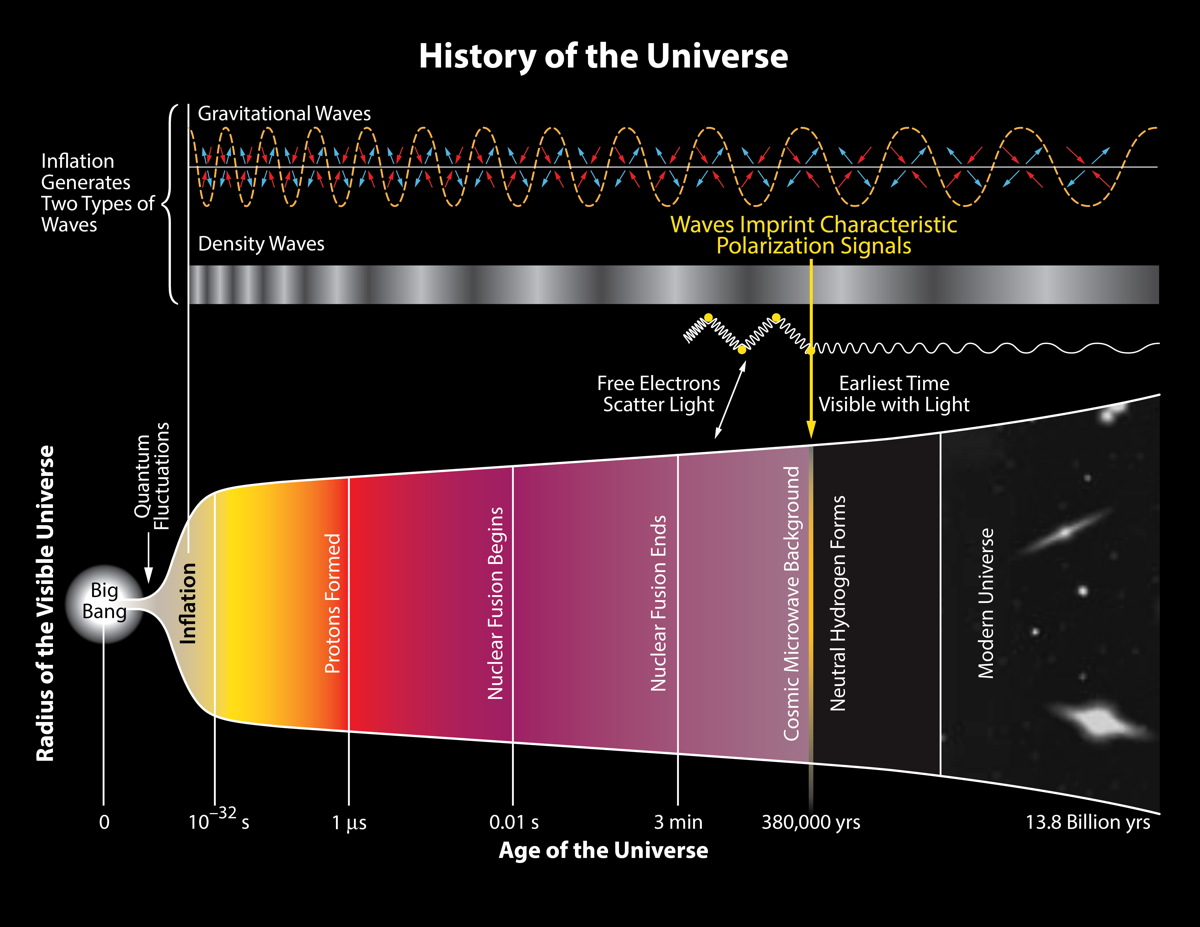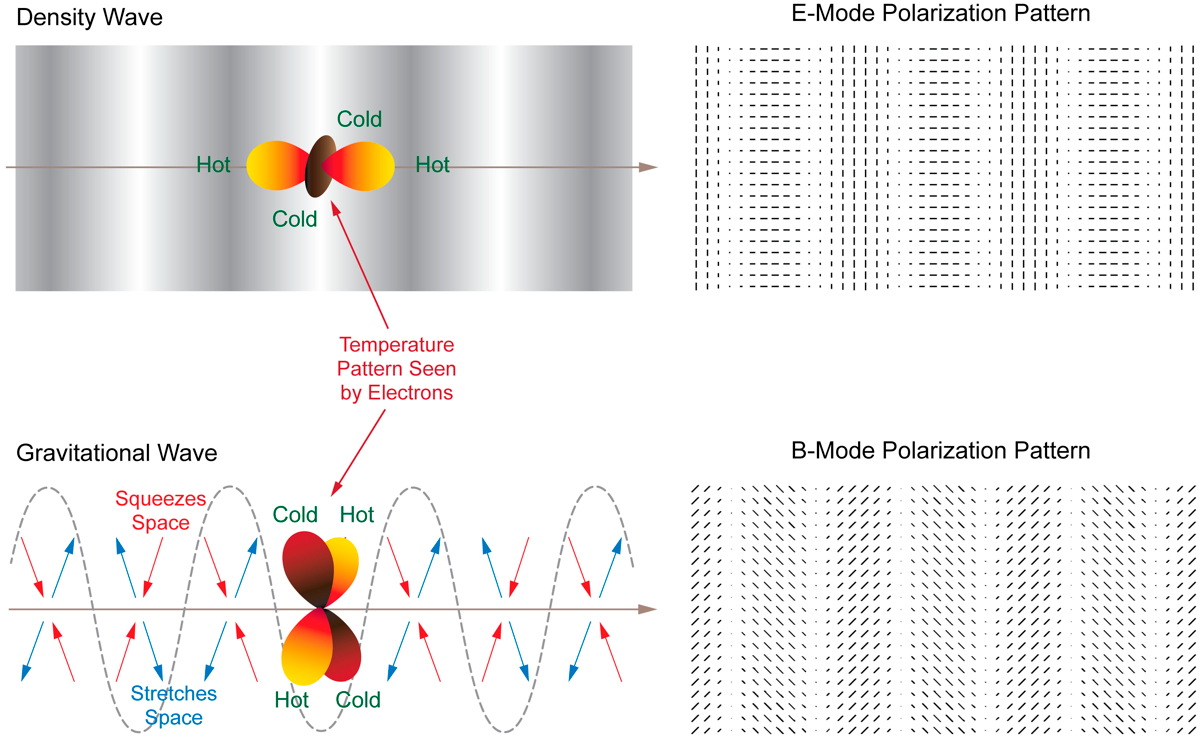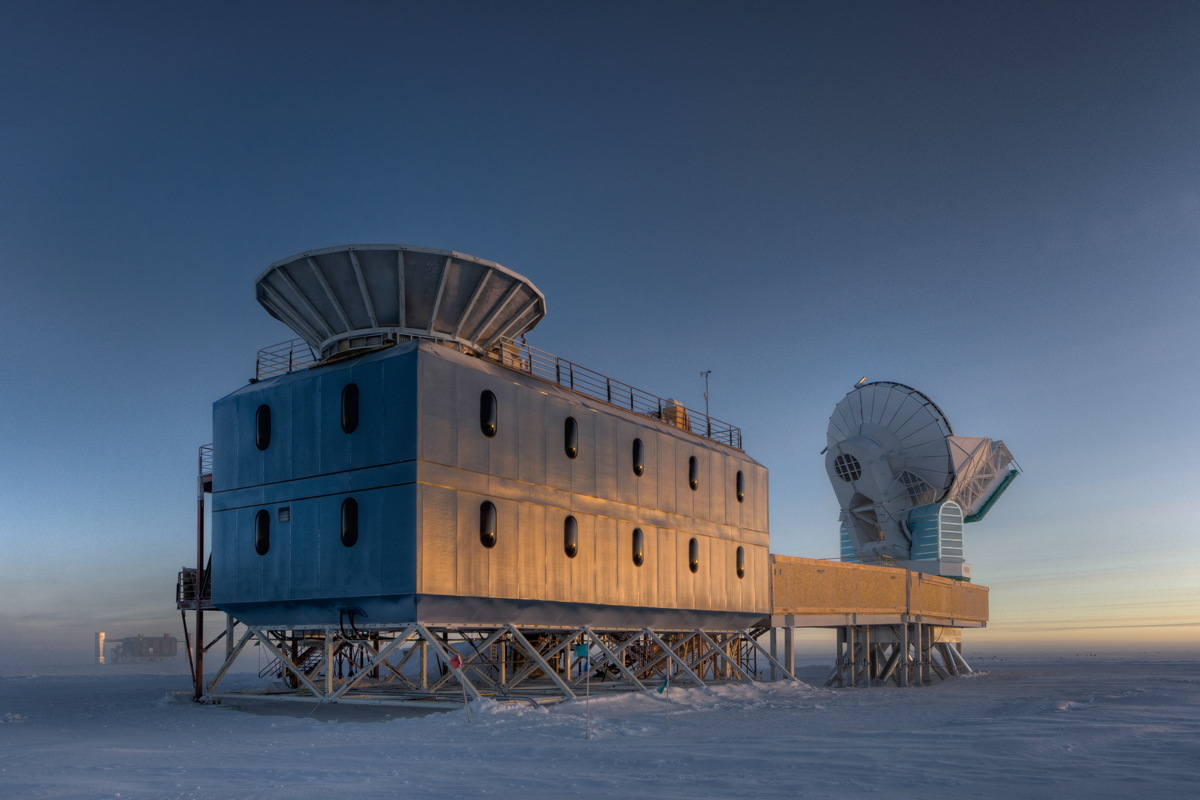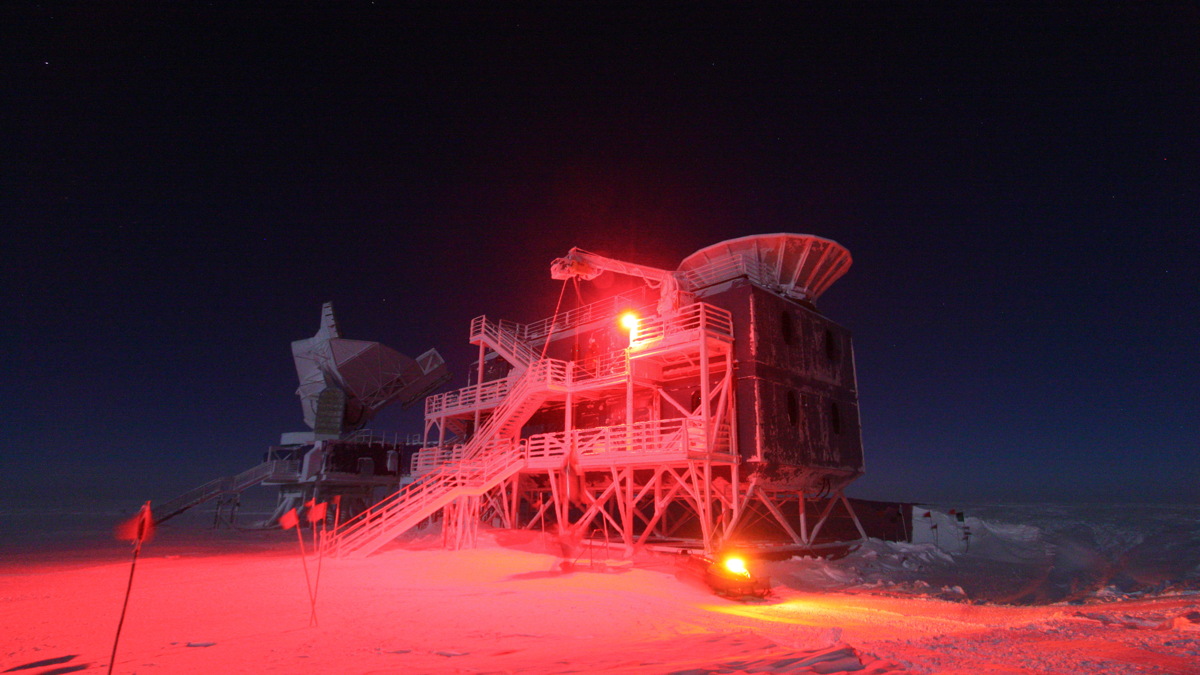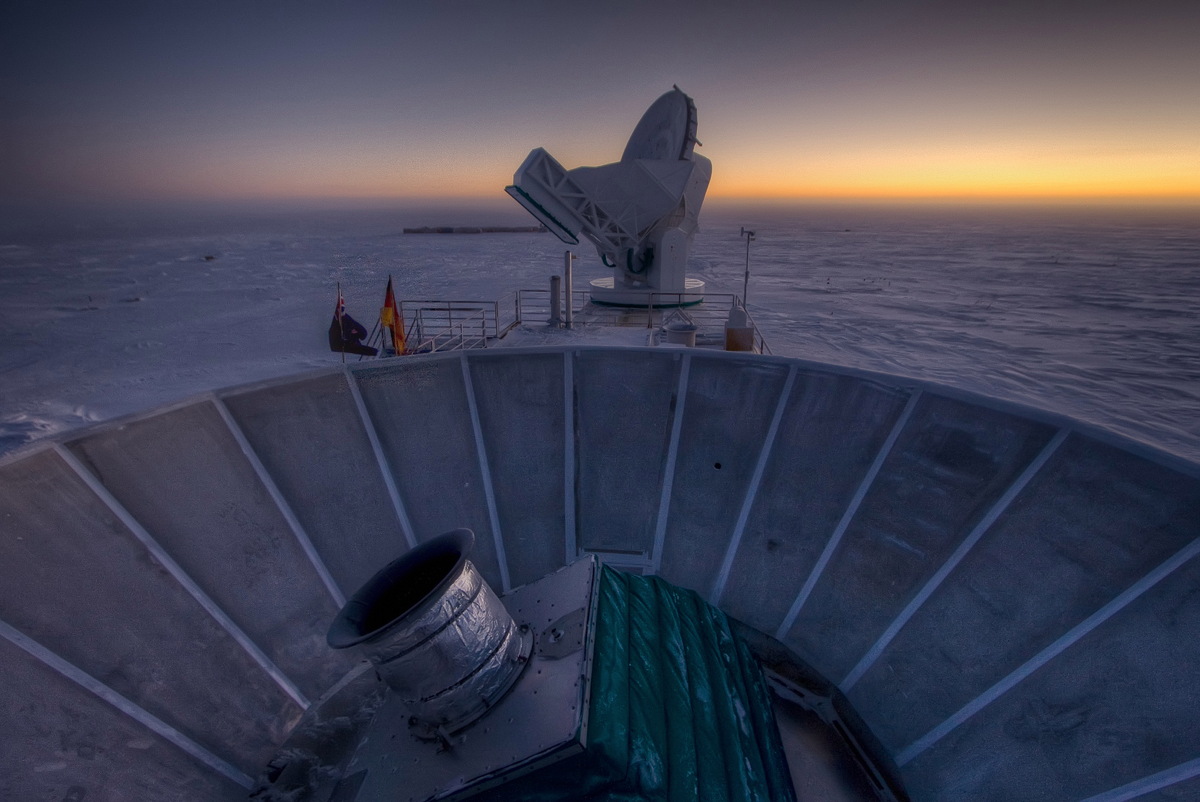Cosmic Inflation and Gravitational Waves: Discovery Images
B-Mode Pattern Observed with the BICEP2 Telescope
Gravitational waves from inflation generate a faint but distinctive twisting pattern in the polarization of the cosmic microwave background, known as a "curl" or B-mode pattern. For the density fluctuations that generate most of the polarization of the CMB, this part of the primordial pattern is exactly zero. Shown here is the actual B-mode pattern observed with the BICEP2 telescope, which is consistent with the pattern predicted for primordial gravitational waves. The line segments show the polarization strength and orientation at different spots on the sky. The red and blue shading shows the degree of clockwise and anti-clockwise twisting of this B-mode pattern. [Read full story.]
B-Mode Polarization Pattern Observed by BICEP2
The tiny temperature fluctuations of the cosmic microwave background (shown here as color) trace primordial density fluctuations in the early universe that seeded the later growth of galaxies. These fluctuations produce a pattern of polarization in the CMB that has no twisting to it. Gravitational waves from inflation are expected to produce much a fainter pattern that includes twisting ("B-mode") polarization, consistent with the pattern observed by BICEP2, which is shown here as black lines. The line segments show the polarization strength and orientation at different spots on the sky. [Read full story.]
History of the Universe Illustration
The bottom part of this illustration shows the scale of the universe versus time. Specific events are shown such as the formation of neutral Hydrogen at 380 000 years after the big bang. Prior to this time, the constant interaction between matter (electrons) and light (photons) made the universe opaque. After this time, the photons we now call the CMB started streaming freely. The fluctuations (differences from place to place) in the matter distribution left their imprint on the CMB photons. The density waves appear as temperature and "E-mode" polarization. The gravitational waves leave a characteristic signature in the CMB polarization: the "B-modes". Both density and gravitational waves come from quantum fluctuations which have been magnified by inflation to be present at the time when the CMB photons were emitted. [Read full story.]
Polarization Diagram of the Cosmic Microwave Background
This illustration displays the mechanism by which density and gravitational waves produce E- and B-mode patterns in the polarization of the CMB. For a single density wave propagating in the direction of the arrow, an electron will always see hotter and colder photons in a direction parallel or perpendicular to the plane of this single wave (a plane at right angles to the arrow). Regardless of the direction of the density wave, this can thus only produce E-mode polarization patterns (upper right). A single gravitational wave is more complex. Although it propagates in the same direction as the density wave, it stretches and squeezes space in a direction perpendicular from it. Depending on the orientation of this stretch/squeeze motion, the gravitational wave is capable of producing either E- or B-mode polarization patterns (lower right). The structure of the universe at the moment the CMB was emitted is a large combinations of these density and gravitational waves. This illustration displays the mechanism by which density and gravitational waves produce E- and B-mode patterns in the polarization of the CMB. For a single density wave propagating in the direction of the arrow, an electron will always see hotter and colder photons in a direction parallel or perpendicular to the plane of this single wave (a plane at right angles to the arrow). [Read full story.]
South Pole Dark Sector
A LC-130 aircraft is passing the NSF South Pole station Dark Sector during take off. CMB telescopes visible in the background include (left to right) the South Pole Telescope, the BICEP2 telescope, and the Keck Array telescope. [Read full story.]
Dark Sector Lab
The Dark Sector Lab (DSL), located 3/4 of a mile from the Geographic South Pole, houses the BICEP2 telescope (left) and the South Pole Telescope (right). [Read full story.]
BICEP2 Electronics Testing
Graduate student Justus Brevik tests the BICEP2 readout electronics. [Read full story.]
Breaking space news, the latest updates on rocket launches, skywatching events and more!
BICEP2 Focal Plane
The BICEP2 telescope’s focal plane consists of 512 superconducting microwave detectors, developed and produced at NASA’s Jet Propulsion Laboratory. [Read full story.]
Superconducting Detectors for Study of Infant Universe
The BICEP2 telescope at the South Pole uses novel technology developed at NASA's Jet Propulsion Laboratory in Pasadena, Calif. The focal plane shown here is an array of devices that use superconductivity to gather, filter, detect, and amplify polarized light from the cosmic microwave background -- relic radiation left over from the Big Bang that created our universe. Image released March 17, 2014. [Read full story.]
Liquid Helium Delivery
Liquid Helium is being delivered by snowmobile to BICEP2. [Read full story.]
BICEP 2 Sunset
The sun sets behind BICEP2 (in the foreground) and the South Pole Telescope (in the background). [Read full story.]

Space.com is the premier source of space exploration, innovation and astronomy news, chronicling (and celebrating) humanity's ongoing expansion across the final frontier. Originally founded in 1999, Space.com is, and always has been, the passion of writers and editors who are space fans and also trained journalists. Our current news team consists of Editor-in-Chief Tariq Malik; Editor Hanneke Weitering, Senior Space Writer Mike Wall; Senior Writer Meghan Bartels; Senior Writer Chelsea Gohd, Senior Writer Tereza Pultarova and Staff Writer Alexander Cox, focusing on e-commerce. Senior Producer Steve Spaleta oversees our space videos, with Diana Whitcroft as our Social Media Editor.
